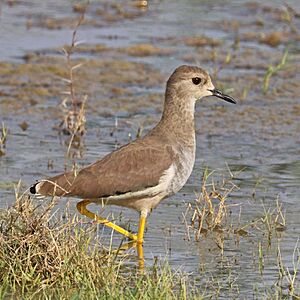White-tailed lapwing facts for kids
Quick facts for kids White-tailed lapwing |
|
|---|---|
 |
|
| Keoladeo National Park, Bharatpur, India | |
| Conservation status | |
| Scientific classification | |
| Genus: |
Vanellus
|
| Species: |
leucurus
|
| Synonyms | |
|
Charadrius leucurus Lichtenstein, 1823 |
|
The white-tailed lapwing (Vanellus leucurus) is a cool bird that loves wet places. It's also sometimes called the white-tailed plover. This bird is a type of wader, which means it spends its time near water, looking for food. The name Vanellus comes from an old Latin word for "lapwing." The second part, leucurus, is from Ancient Greek and means "white-tailed," which perfectly describes this bird!
Contents
Meet the White-tailed Lapwing
What Does It Look Like?
The white-tailed lapwing is a medium-sized bird. It has long legs and a fairly long beak. Adult birds look very neat and upright. They have a brown back and the front of their neck is also brown. Their face is a bit lighter, and their chest is grey.
What makes them easy to spot are their bright yellow legs and a tail that is completely white! Their wings are a mix of brown, white, and black, making them very unique. Younger birds might have a scaly pattern on their back. They might also have some brown feathers in their tail.
What Does It Eat?
This lapwing is special because it's one of the few lapwings that can be seen in water that's not super shallow. It likes to pick up insects and other small creatures. It mostly finds its food right from the water's surface.
What Does It Sound Like?
When it's breeding season, the white-tailed lapwing makes a sound like "peewit." This call is quite similar to the sound made by another bird, the northern lapwing.
Where Do White-tailed Lapwings Live?
Breeding Grounds
White-tailed lapwings like to nest together in groups. They build their nests in inland marshes. You can find them breeding in countries like Iraq, Kuwait, Iran, and southern Russia. They lay about four eggs right on the ground.
Migration and Travel
Some white-tailed lapwings, especially those in Iraq and Iran, tend to stay in the same area all year. They are called residents. But the birds from Russia are different! They are migratory. This means they fly south for the winter. They travel to places like the Indian Subcontinent, the Middle East, and northeast Africa.
Sometimes, a white-tailed lapwing might fly far off course. They are very rare visitors in western Europe. The first time one was seen in Britain was on July 12, 1975, in a place called Packington.
Protecting These Birds
Challenges They Face
In some areas where the white-tailed lapwing lives, these birds face challenges. Their homes, the marshes, can be damaged or disappear. This is called habitat destruction. Sometimes, they also face dangers from accidental harm.
How We Help
The white-tailed lapwing is an important bird. It is one of the species protected by an agreement called the Agreement on the Conservation of African-Eurasian Migratory Waterbirds (AEWA). This agreement helps protect birds that fly long distances between Africa, Europe, and Asia. It's important to keep their habitats safe so these amazing birds can continue to thrive!
Images for kids



